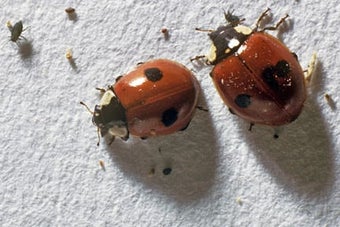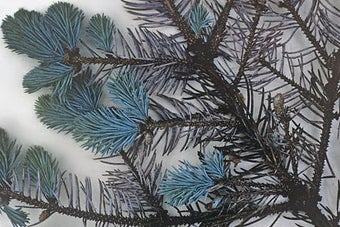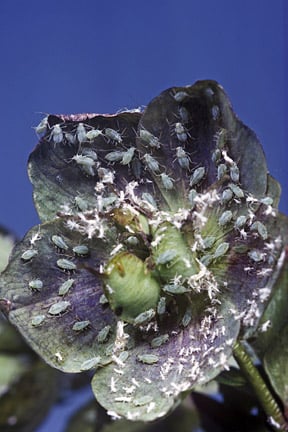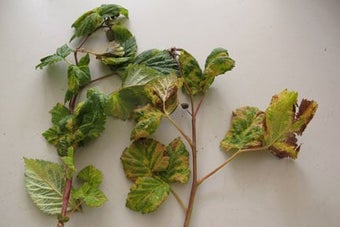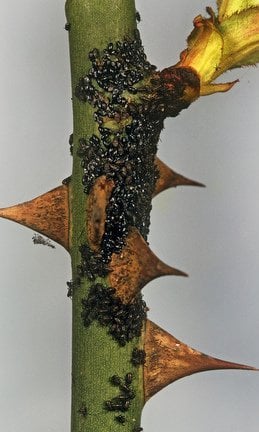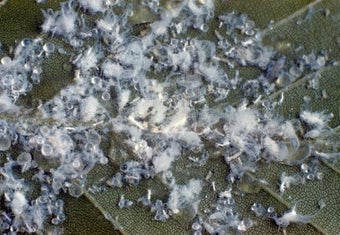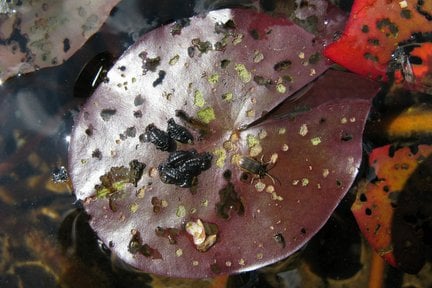
Quick facts
Common names - Waterlily aphid, waterlily beetle, brown China mark moth, chironomid midge
Scientific names - Rhopalosiphum nymphaeae, Galerucella nymphae, Elophila nymphaeata, Chironomidae
Plants affected - Waterlilies (Nymphaea)
Main symptoms - Leaves eaten, having a ragged appearance
Most active - Summer
What are waterlily invertebrates?
Waterlilies can be fed upon by several invertebrates, all tend to be sporadic and damaging populations do not usually occur year after year.
Waterlily aphid, Rhopalosiphum nymphaeae is a small (1.5-2.5 mm) reddish brown or dull green aphid. It sucks from the upper surface of leaves and flower . Its prefered hosts are waterlilies but it can feed on some other aquatic plants. Plant damage usually only occurs during the summer months if dense colonies develop on the leaves and flower buds. The aphid spends the winter as eggs on Prunus species and it forms spring colonies on these plants before migrating to waterlilies by early summer. This aphid does not usually have a noticeable affect on the spring host.
Water lily beetle, Galerucella nymphae is a 6-7 mm long greyish brown beetle. The adult and its black grubs feed on foliage and flower buds during the spring and summer. They feed by grazing away the upper leaf surface and create elongate slots in the leaves. The dark pupae may also be found on the leaves. Badly affected leaves can rot and disintegrate. The beetle is capable of flight and overwinters as adults in sheltered places, often away from ponds.
Brown China mark moth, Elophila nymphaeata is one of several moths that have aquatic caterpillars. The adult moth has a wingspan of 20-30 mm and is variable in wing colouration, most often being brown with white spots. The caterpillars of this and some closely related species feed on a range of aquatic plants including waterlilies. Initially the caterpillar forms a leaf mine but later stages feed under a fold of leaf material. As with waterlily beetle affected leaves can rot and disintegrate. Adults can be found in July and August, caterpillars can be found throughout the year.
Chironomid midges are a family of flies many of which have aquatic larvae. The adults are gnat or mosquito like, although they do not bite. Usually the slender larvae (maggots) feed on decomposing matter at the bottom of ponds. They will however, feed on waterlilies that have begun to rot due to other causes, such as waterlily beetle damage. Occasionally chironomid midges are the primary cause of damage this tends to happen only in new ponds and water features. These insects are present throughout the year.
Pond snails. Most pond snails do not damage healthy plants preferring to feed on decomposing plant matter and algae. They do however, often lay elongate (approx. 2 cm) gelatinous egg sacks, on the undersides of waterlilies.

Management
- Waterlily invertebrates are difficult to manage and in most cases must be tolerated. Most of these animals are sporadic and do not usually occur every year on the same patch and the waterlilies recover
- Waterlily aphids and beetles can be wiped off the leaves and . This is feasible on small ponds where the lily leaves are within reach from the sides of the pond. They often have to be tolerated in larger ponds




